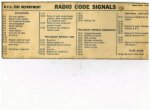I recall back in the late 70's early 80's I guess a signal 10-30 . We had plenty of those in my old neighborhood of East Harlem 53/43 and from what I remember 2 & 2 would be assigned for what felt like an extended operation. Clutter , abandoned buildings too unstable to enter. Can anyone fill me in this response? Thanks
You are using an out of date browser. It may not display this or other websites correctly.
You should upgrade or use an alternative browser.
You should upgrade or use an alternative browser.
FDNY SIGNAL 10-30
- Thread starter tperez102
- Start date
A 10-30 code now is only used internally for Dispatchers now. The field units do not use it.
I believe now it is just used to fill out the box with a 4th engine and Squad and Rescue if the quantity and quality of calls suggest it will be a 10-75
Any dispatchers please correct me if I'm wrong.
I believe now it is just used to fill out the box with a 4th engine and Squad and Rescue if the quantity and quality of calls suggest it will be a 10-75
Any dispatchers please correct me if I'm wrong.
Thank You NFD that's how I remember it. We had tenements in our area that were just shells. One building an Old School still there east 105th st Box 1302 , was constantly burning. I still remember the War years looking out my windows on the 12th floor and seeing smoke column's daily.
Thanks To you all for the reply and info.
Thanks To you all for the reply and info.
My recollection is a 3 & 2 + Bn response on pull boxes. The Bn would, depending on his size-up, would not use the 3rd engine, thereby not transmitting the 10-75 & not having the Deputy & Rescue & Squad respond. Especially when things were popping. ERS changed things.
Obviously, the dispatcher could redirect or assign extra units based on their info.
Obviously, the dispatcher could redirect or assign extra units based on their info.
10 codes were established in 1969. 10-30 was "Working Fire" order for a Full First Alarm Assignment which was 3+2+BC, there was no 10-75.
Some years later 10-75 was established calling for the 3+2+BC response. At that time response to the 10-30 was reduced to 2+2+BC.
Some years later 10-75 was established calling for the 3+2+BC response. At that time response to the 10-30 was reduced to 2+2+BC.
Attachments
I recall back in the late 70's early 80's I guess a signal 10-30 . We had plenty of those in my old neighborhood of East Harlem 53/43 and from what I remember 2 & 2 would be assigned for what felt like an extended operation. Clutter , abandoned buildings too unstable to enter. Can anyone fill me in this response? Thanks
I was an FDNY "scanner buff" in the mid through late 1970's. My impression was Company Officers (LT's & CAPT's) would transmit a 10-30 upon arrival at a job and leave it to the responding BC to transmit a 10-75. I don't know if this was an unwritten rule or protocol, it just seemed to be the way it was when I listened. When a Company Officer did transmit a 10-75 then the fire was really ripping and possibly with life safety issues.
I was under the impression that the 10-30, which brought 2 engines, 2 ladders, and a B.C. to a box, came about around the time the adaptive response was initiated.
Adaptive response had a 2 & 1 response with a B.C., so the 10-30 brought an additional truck.
Correct me if I haven't got it right.
Adaptive response had a 2 & 1 response with a B.C., so the 10-30 brought an additional truck.
Correct me if I haven't got it right.
Ken, you are right, I meant to include that in my remarks above. During adaptive response hours pull boxes with a history of mfa's would get a 2&1 and BC response. 10-30 told the dispatchers the 2nd truck was needed. I recall jobs developing with the 1st arriving company transmitting a 10-30, and the BC transmitting a 10-75 and then an All Hands, Division Chiefs usually transmitted the greater alarms.
- Joined
- Mar 3, 2007
- Messages
- 1,517
How many times, on a busy night, did we hear "....are there any available ladder companies in the ______ Division?...". Or a chief asking for additional companies only to be told by the dispatcher "...there are companies responding, but they are coming from a distance..."
There were lots of times when a Chief had to make do with what he had on scene.
How many times did a company in a busy area turn out on its first run shortly after 6 PM, pick up multiple runs on the air and not return to quarters for several hours?
Ah, the good old days
There were lots of times when a Chief had to make do with what he had on scene.
How many times did a company in a busy area turn out on its first run shortly after 6 PM, pick up multiple runs on the air and not return to quarters for several hours?
Ah, the good old days


